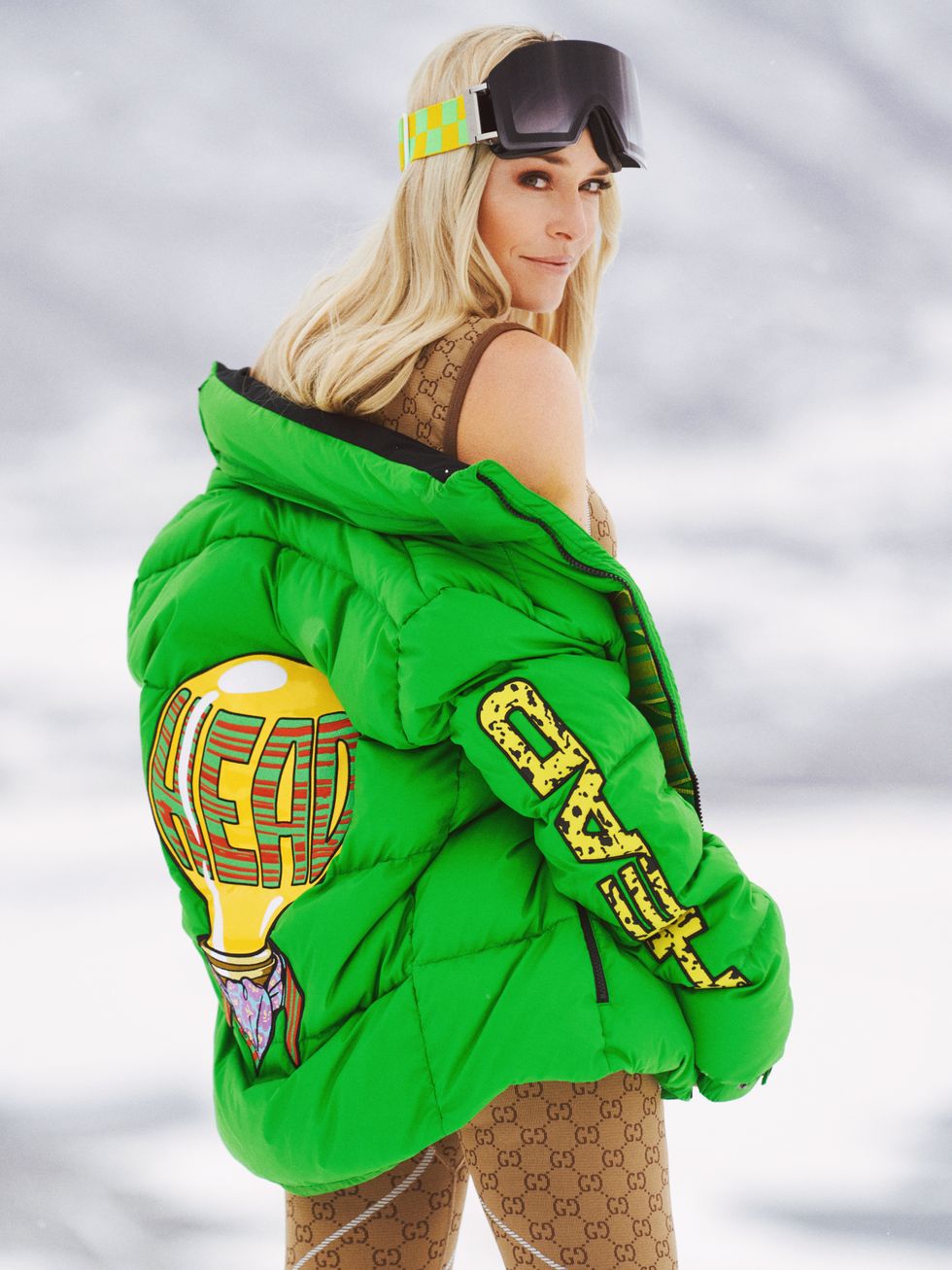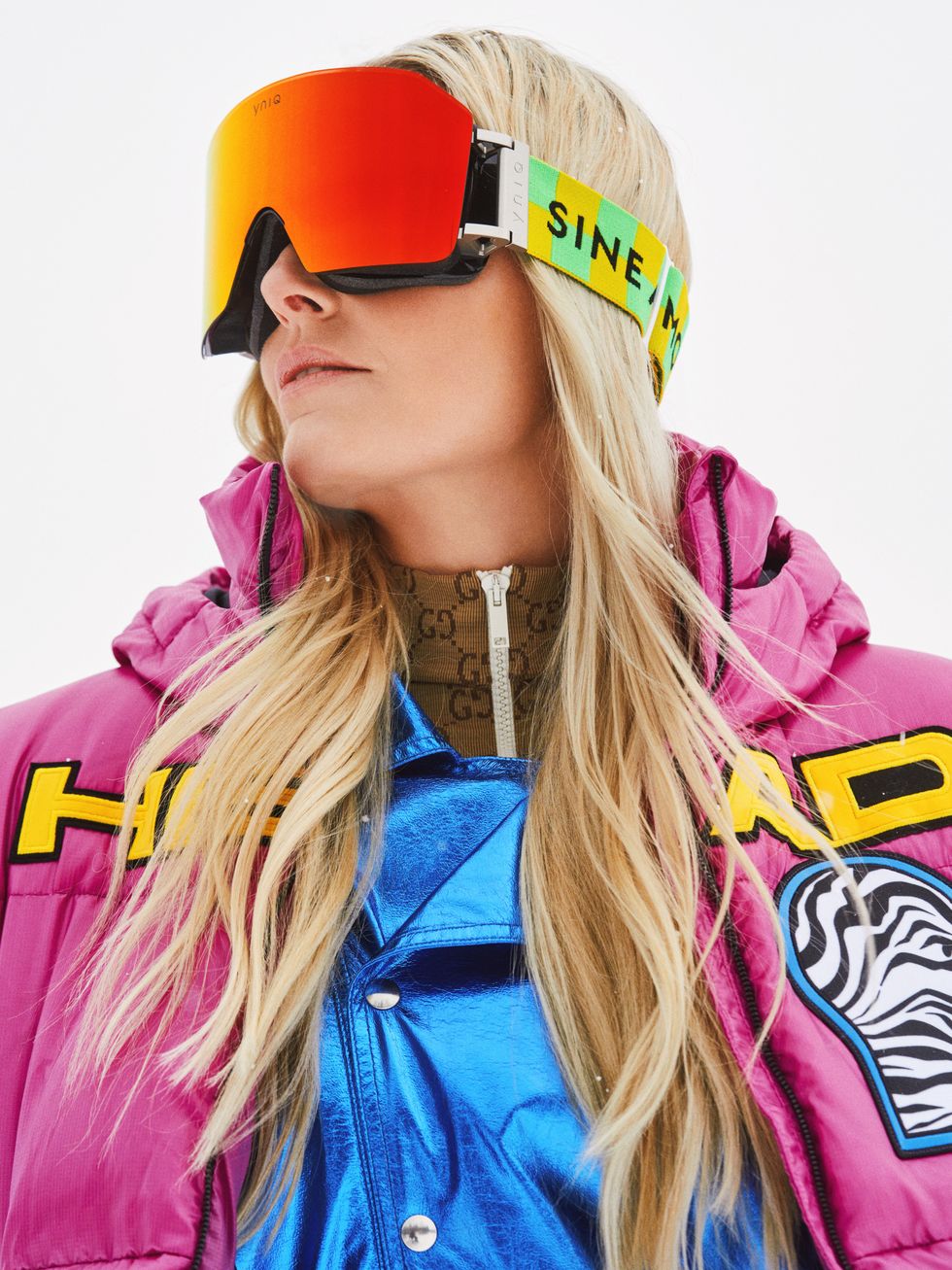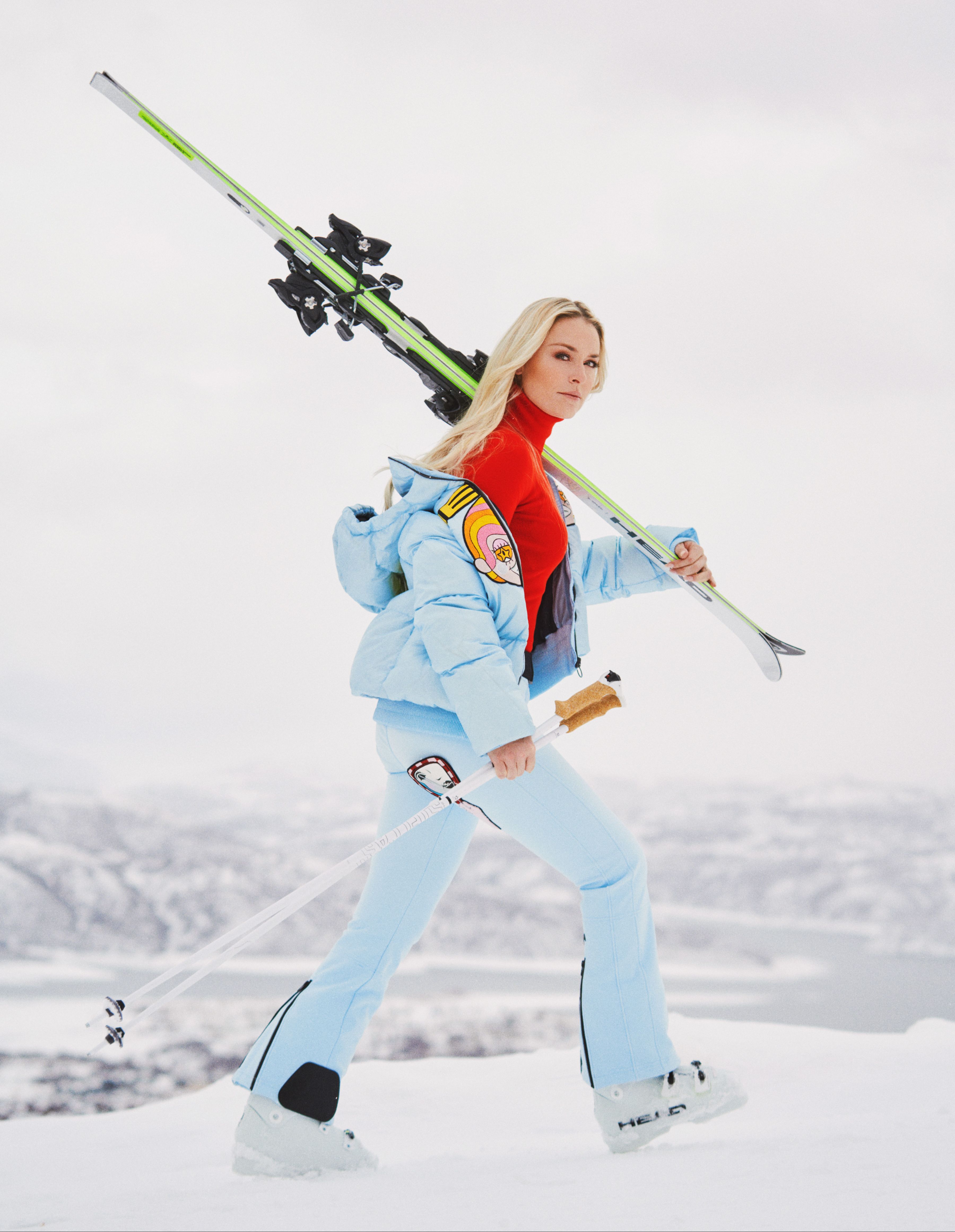Greatness attracts greatness. So it makes sense, then, that Gucci Vault is teaming up with champion skier Lindsey Vonn to launch “Vault Altitude,” a curation of exclusive collections by eight different brands inspired by the whimsy of bluebird powder days and opulent après-ski fêtes. “No one does it like Gucci does it,” the four-time overall World Cup winner tells ELLE.
For the uninitiated, Vault is Gucci’s experimental concept store that stocks both vintage items and pieces by up-and-coming designers. Vault Altitude is its curated winter capsule featuring an assortment of ready-to-wear shoes, accessories, jewelry, and ski gear from labels like HEAD Sportswear and Yniq, where Vonn is a shareholder and member of its design and development team. “It was perfect synergy with Gucci,” Vonn says. “Gucci [conceived] everything to go well together and have one [streamlined] concept. It turned out amazingly well.”
The highly curated pieces (now available on Vault’s online shop) capture an exciting emerging aesthetic—one that merges utilitarian skiwear with emerging street style. “I’ve obviously skied my whole life and seen that potential,” Vonn says. “Now other people are finally seeing what I’ve seen all along.” Below, the skier talks about the exclusive new Vault collection, her love for “retro, ’70s, Robert Redford-type” ski apparel, and why we need to talk more about equal pay in women’s sports.
How did this partnership come about?
We’ve been working on this for a few months now, and it came together pretty quickly. It was a really natural fit. It’s an experimental concept, merging historical vibes with forward thinking. That’s how Gucci always does everything. There were just so many synergies between Gucci’s approach to Vault and myself, and what we were trying to achieve.
And what is it that you’re trying to achieve exactly?
We’re creating something new, something really special that no one else has seen before. Something that melds luxury and sophistication, with amazing technology.
You had me hooked at melding luxury with amazing technology! Tell me more.
I’ve always loved a retro, ’70s, Robert Redford-type design. So we took that aesthetic and mixed it with new-age tech. I look at every detail, even the zippers and pocket placement. I’ve been on the mountain my whole life, so these are the little things I think about. As far as the actual fabrics, the technology in the line is incredible. We have, in my opinion, the best-performing ski wear on the market, hands down.
Do you think that skiwear is becoming the new street style?
You see so many fashion houses doing ski lines now, but a majority of the consumers don’t actually ski. The style that was born in Aspen and on the mountain in Europe, especially in St. Moritz [in Switzerland], is now being emulated in street style. You see New Yorkers wearing mountain boots and mountain-chic après-ski outfits. It’s really transitioning into everyday culture.
How would you describe your own style?
I have a pretty classic style. I like to be monochromatic, with some flair. I like being fashion-forward, but not overly abrasive. I love the blended athleisure and high fashion look. Cashmere loungewear is simply the best. You don’t need to have every piece be something extraordinary. You can add certain pieces in that really make your style come to life and have more energy.
Who is your current style icon?
Lewis Hamilton is really forward-thinking in everything he does. I like how he pushes the envelope. I’m inspired by that. I’m a little more conservative, but I like trying new things and seeing what’s possible.
What brands have been catching your eye lately?
I’m a huge fan of vintage Tom Ford and Tom Ford-era Gucci. I’ve worn a couple of his pieces for events. I’ve definitely gravitated to vintage on the last few red carpets, because it’s on-trend and also vintage looks are so classic. I really love the timelessness and class of vintage.
Where do you shop for vintage pieces?
I go to Albright in New York City. They have amazing stuff. There’s another store in New York called What Goes Around Comes Around. There aren’t a ton of great vintage stores in Utah [where I live], and in L.A. I’m still looking for a good place. Do you have any recommendations?
I do! I’ll send you a list. Switching gears, I wanted to talk about an issue that’s personal to you: the prioritization of mental health.
Thanks for bringing that up. My mental health journey has been a long one and, for the most part, I did it alone. I never really went to a therapist when I was racing. I used ski racing more as a tool for therapy than anything else. It wasn’t until 2012 that I started opening up and talking about mental health. At the time, it wasn’t received well by everyone. I wish I’d had a bit more support. Everyone has their own journey, and finding your own way through it and finding support is the most important thing.
When I retired, I started working with an amazing therapist named Armando González. He taught me how to take care of myself. I’ve always been a huge proponent of journaling. Writing things down is a good way to process what you’re feeling and going through. I’m really happy with the way the conversation of mental health is going right now. People like Michael Phelps and Kevin Love and Simone Biles have done so much to make mental health and depression and anxiety less stigmatized.
Do you think retired athletes have different mental health struggles than athletes who are currently competing?
There’s definitely an added component when you retire. Actually, it’s much worse. When you’re competing, there’s the added distraction of the competition. For me, in a lot of ways, that was a really good way to cope. I never had a problem with anxiety. When you compete at the highest level, there’s always going to be pressure. There’s always going to be expectations that you put on yourself and that everyone else puts on you. To win, you have to be able to manage those emotions and expectations. I found my depression was difficult when I was alone, traveling on the road. Everyone who saw me winning thought that ski racing was this glamorous lifestyle. But at the end of the day, I came home to an empty hotel room, and I was away from home for six months at a time. It was really challenging. Then, when I retired, there was no outlet, no distraction. I didn’t get to race. I was actually around less people. So, in a lot of ways, I felt even more isolated. On both sides, it was important to find an outlet and a way to cope and manage what I was feeling.
You mentioned journaling as a form of therapeutic release. How else do you practice self-care?
Getting my dog Lucy and my other two dogs really, really helped. I felt so much more at home when I had my dog to come home to. Lucy doesn’t care if I win or lose. She’s happy to see me either way. It was more complicated traveling with a dog on the World Cup circuit and taking her to the Olympics in Korea. But it was so necessary. Animals offer a lot of emotional support. Some people don’t take that seriously, but I feel that animals can have a huge impact on mental health.
Is mental health advocacy something the Lindsey Vonn Foundation is focusing on?
It’s a huge priority for us. We host camps for young girls in underserved communities, and mental health is one of our biggest points of conversation. When the girls come for the two-day long session, we go through the curriculum and teach them different ways to build friendships, engage in positive self-talk, and prioritize mental health. It really has nothing to do with skiing. I just want to empower girls in any way possible.
Speaking of women looking out for other women, the return of Brittney Griner has reignited a conversation about pay equity in women’s sports. Where are we in this ongoing fight?
I think everyone can agree that it’s great to have Britney home. And the conversation of pay equity is a really important one, because it’s not that women want to be paid as much as LeBron James. They just want to be paid in the same percentage and to be valued in the same way. That’s an important detail for everyone to understand. Everyone is doing such a good job fighting for this, but this conversation won’t be over anytime soon.
You recently signed a two-year first-look deal with CBS Studios through your production company Après Productions. Is pay equity one of the issues you’ll be prioritizing?
We have a bunch of projects that CBS is really excited about, and we’re currently working with some writers to get things going. They’re still in the works, I’ll let you know more when I can.
This interview has been lightly edited and condensed for clarity.
Photographer: Sebastian Kim; stylist: Sarah Zendejas; hair: Graham Nation at The Wall Group; makeup: Karan Mitchell at TMG-LA; stylist assistant: Rosie Jarman; production: Area1202; special thanks to the Deer Valley Resort, Visit Park City, and Park City Peaks Hotel

Senior Editor
Rose is a Senior Editor at ELLE overseeing features and projects about women’s issues. She is an accomplished and compassionate storyteller and editor who excels in obtaining exclusive interviews and unearthing compelling features.













